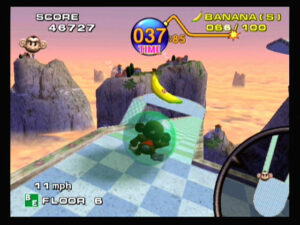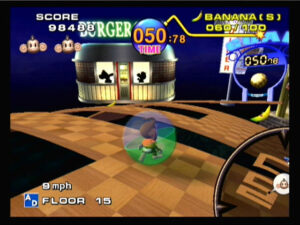


Super Monkey Ball : Banana Rumble (eShop) Nintendo Switch
- 11 users on this page
- No Other Version
- No Other Delivery
19,22 €
Visuals







About
Super Monkey Ball is a 2001 platform party video game developed by Amusement Vision and published by Sega. The game debuted in Japan at the 2001 Amusement Operators Union trade show as Monkey Ball, an arcade cabinet running on Sega’s NAOMI hardware and controlled with a distinctive banana-shaped analog stick. Due to the failure of Sega’s Dreamcast home console and the company’s subsequent restructuring, an enhanced port dubbed Super Monkey Ball was released as a launch title for the GameCube in late 2001, garnering interest as Sega’s first game published for a Nintendo home console. Conceived by Amusement Vision head
Developer :
SEGA
Publisher :
Amusement Vision
Release Date :
January 2, 2001
Genre :
User Tags*:
Editions

Super Monkey Ball : Banana Rumble (eShop) Nintendo Switch
-32%
19,22 €

Super Monkey Ball : Banana Rumble (eShop) Nintendo Switch
-32%
19,22 €

Super Monkey Ball : Banana Rumble (eShop) Nintendo Switch
-32%
19,22 €

Super Monkey Ball : Banana Rumble (eShop) Nintendo Switch
-32%
19,22 €

Super Monkey Ball : Banana Rumble (eShop) Nintendo Switch
-32%
19,22 €

Super Monkey Ball : Banana Rumble (eShop) Nintendo Switch
-32%
19,22 €

Super Monkey Ball : Banana Rumble (eShop) Nintendo Switch
-32%
19,22 €

Super Monkey Ball : Banana Rumble (eShop) Nintendo Switch
-32%
19,22 €
Visuals
Game features
Description
Super Monkey Ball is a 2001 platform party video game developed by Amusement Vision and published by Sega. The game debuted in Japan at the 2001 Amusement Operators Union trade show as Monkey Ball, an arcade cabinet running on Sega’s NAOMI hardware and controlled with a distinctive banana-shaped analog stick. Due to the failure of Sega’s Dreamcast home console and the company’s subsequent restructuring, an enhanced port dubbed Super Monkey Ball was released as a launch title for the GameCube in late 2001, garnering interest as Sega’s first game published for a Nintendo home console.
Conceived by Amusement Vision head Toshihiro Nagoshi, Super Monkey Ball involves guiding a transparent ball containing one of four monkeys—AiAi, MeeMee, Baby, and GonGon—across a series of maze-like platforms. The player must reach the goal without falling off or letting the timer reach zero to advance to the next stage. There are also several multiplayer modes: independent minigames as well as extensions of the main single-player game.
Super Monkey Ball received highly positive reviews from critics, who praised the simplicity and subtle depth of its control scheme as well as the new multiplayer modes not present in its arcade counterpart, although some felt its presentation was lacking. The game was commercially successful and remained one of Sega’s best-sellers in the United States for much of 2002, eventually spawning a direct sequel, Super Monkey Ball 2, and an entire Super Monkey Ball franchise.




